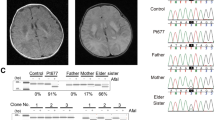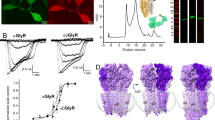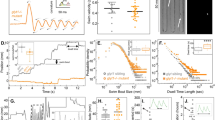Abstract
We investigated the molecular basis of hyperekplexia (STHE), an inherited neurological disorder characterised by neonatal hypertonia and an exaggerated startle response, in a kindred and identified a novel missense mutation in the pore-lining M2 domain of the α1 subunit of the glycine receptor (GLRA1). Sequencing analysis of all exons of the GLRA1 gene revealed a G1158A base transition in affected, heterozygous patients. The base transition results in a valine to methionine substitution at codon 260 in the middle of the M2 transmembrane domain. The location within the M2 domain suggests for this substitution a likely role in altering ion channel properties.
Similar content being viewed by others
Log in or create a free account to read this content
Gain free access to this article, as well as selected content from this journal and more on nature.com
or
References
Shiang R, Ryan SG, Zhu YZ, Hahn AF, O Connell P, Wasmuth JJ . Mutation in the alpha 1 subunit of the inhibitory glycine receptor cause the dominant neurologic disorder, hyperekplexia Nat Genet 1993 5: 351–358
Rees MI, Andrew M, Jawad S, Owen MJ . Evidence for recessive as well as dominant forms of startle disease (hyperekplexia) caused by mutations in the alpha 1 subunit of the inhibitor glycine receptor Hum Mol Genet 1994 3: 2175–2179
Langosh D, Thomas L, Betz H . Conserved quaternary structure of ligand-gated ion channels: the post-synaptic glycine receptor is a pentamer PNAS 1988 85: 7394–7398
Lynch JW, Rajendra S, Pierce KD, Handford CA, Barry PH, Schofield PR . Identification of intracellular and extracellular domains mediating signal transduction in the inhibitory glycine receptor chloride channel EMBO J 1997 16: 110–120
Rajendra S, Lynch JW, Pierce KD, French CR, Barry PH, Schofield PR . Startle disease mutations reduce the agonist sensitivity of the human inhibitory glycine receptor JBC 1994 269: 18739–18742
Vigevano F, Di Capua M, Dalla Bernardina B . Startle disease: an avoidable cause of sudden infant death Lancet 1989 28: 216
Elmslie FV, Hutchings SM, Spencer V et al. Analysis of GLRA1 in hereditary and sporadic hyperekplexia: a novel mutation in a family cosegregating for hyperekplexia and spastic paraparesis J Med Genet 1996 33: 435–436
Schofield PR . Genetics, an alternative way to discover, characterize and understand ion channels Clin Exp Pharmacol Physiol 2001 28: 84–88
Milani N, Dalprà L, del Prete A, Zanini R, Larizza L . A novel mutation (Gln 266His) in the alpha 1 subunit of the inhibitory glycine-receptor gene (GLRA1) in hereditary hyperekplexia Am J Hum Genet 1996 58: 420–422
Miller C . Genetic manipulation of ion channels: a new approach to structure and mechanism Neuron 1989 2: 1195–1205
Moorhouse AJ, Jacques P, Barry PH, Schofield PR . The startle disease mutation Q266H, in the second transmembrane domain of the human glycine receptor, impairs channel gating Mol Pharmacol 1999 55: 386–395
Author information
Authors and Affiliations
Corresponding author
Rights and permissions
About this article
Cite this article
del Giudice, E., Coppola, G., Bellini, G. et al. A mutation (V260M) in the middle of the M2 pore-lining domain of the glycine receptor causes hereditary hyperekplexia. Eur J Hum Genet 9, 873–876 (2001). https://doi.org/10.1038/sj.ejhg.5200729
Received:
Revised:
Accepted:
Published:
Issue date:
DOI: https://doi.org/10.1038/sj.ejhg.5200729
Keywords
This article is cited by
-
A novel nonsense autosomal dominant mutation in the GLRA1 gene causing hyperekplexia
Journal of Neural Transmission (2018)
-
The impact of human hyperekplexia mutations on glycine receptor structure and function
Molecular Brain (2014)
-
Hereditary hyperekplexia caused by novel mutations of GLRA1 in Turkish families
Molecular Diagnosis (2004)
-
Hyperekplexia (Startle Disease)
Molecular Diagnosis (2003)



